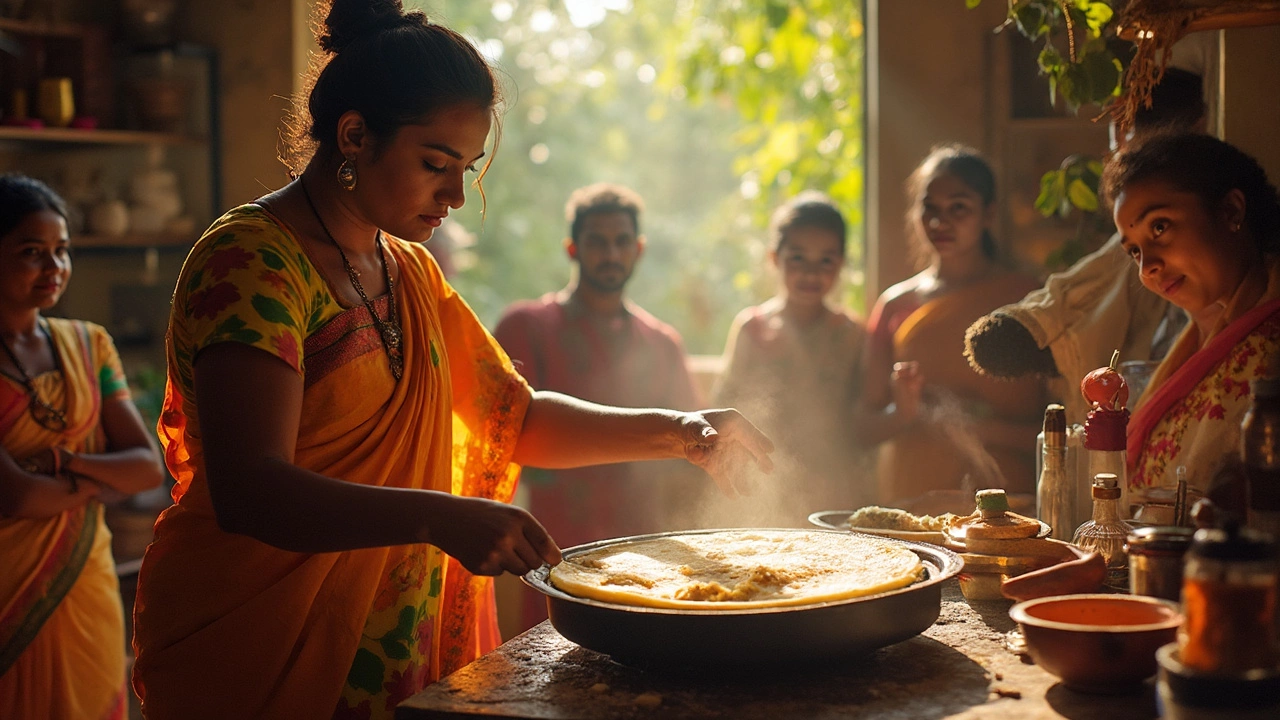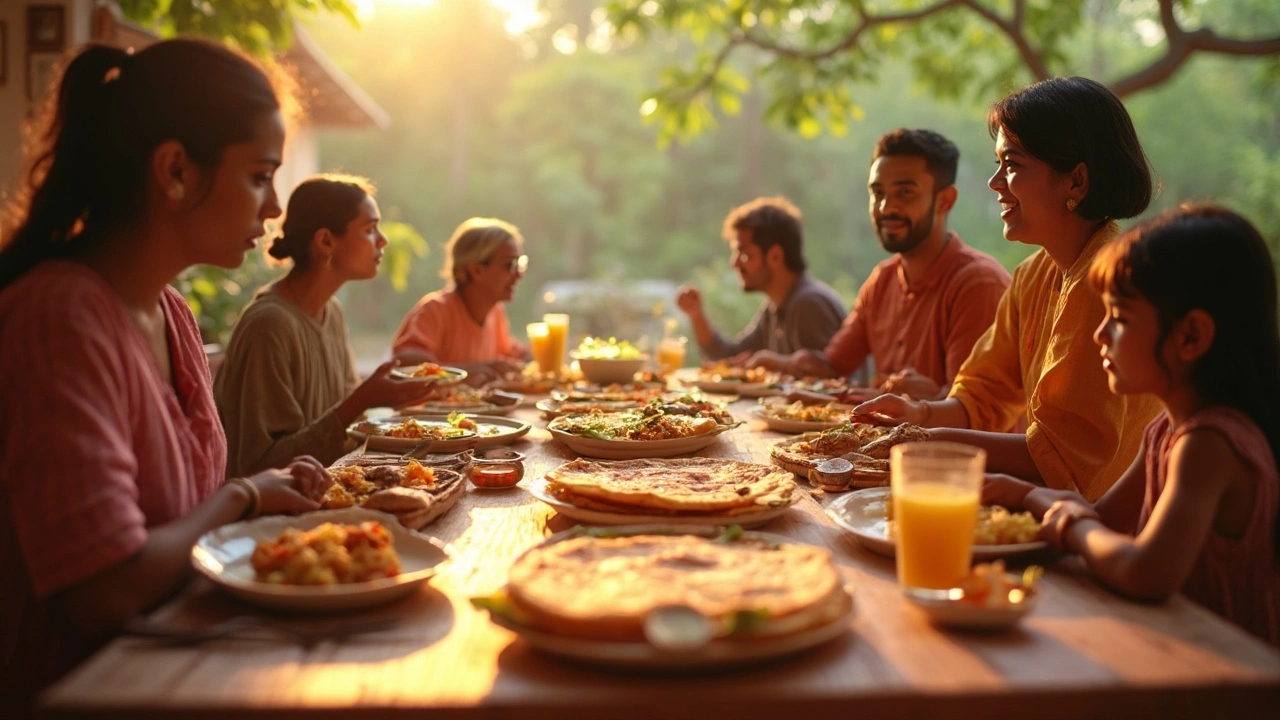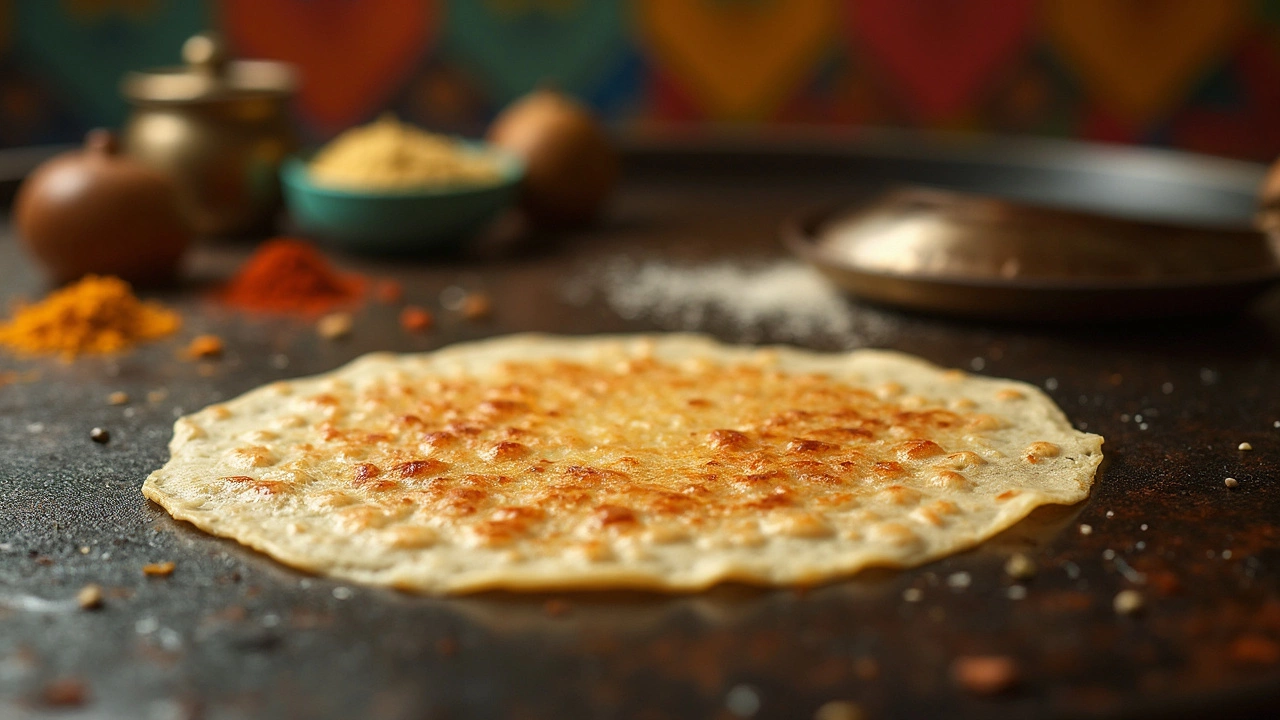Fastest Way to Achieve Soft Dosas Without Yeast
 Feb, 13 2025
Feb, 13 2025
Ever wondered how to make soft dosas without relying on yeast? Let's get right into it. The secret lies in the fermentation process and a good understanding of ingredients. We're talking about common staples like rice and urad dal (split black gram). These are the stars of the show when it comes to dosa batter.
First off, let's chat about the proportions. A typical dosa batter calls for a ratio, by volume, of about 3:1 rice to urad dal. Here's a neat trick: adding a bit of cooked rice to the mix. It can give your dosas that heavenly softness we're after.
So, how do we prep this magic batter? Start by rinsing the rice and dal properly, then soak them separately. This could take about 4-6 hours. You might even notice your kitchen smelling fantastic as the fermentation starts to work its magic!
- Understanding the Basics
- Ingredients and Proportions
- Step-by-Step Preparation
- Tips for Achieving Softness
- Alternative Methods
Understanding the Basics
Let's kick off with the essentials of making soft dosas. The base of this delightful dish is the batter. And believe it or not, the magic happens with just a few simple ingredients: rice and urad dal. This duo is the cornerstone of any dosa recipe, and the process of preparing them is what determines the texture of the final product.
Rice contributes to the structure and crispiness of the dosa, while urad dal adds the essential fluffiness that you're after. When these ingredients are soaked and then ground together, they create a batter that needs to ferment. Fermentation is key because it not only adds a tangy flavor profile but also helps the dosas rise and become airy without the need for yeast.
Always remember, the quality of the water used for soaking and grinding can impact the fermentation process. It's also advisable to maintain a warm temperature for the batter to ferment properly; around 25-30°C (or 77-86°F) is ideal if you're looking to fast-track the process naturally.
| Ingredient | Benefit |
|---|---|
| Rice | Structure & crispiness |
| Urad Dal | Fluffiness & protein |
| Water Quality | Affects fermentation |
If this is all new to you, don't worry. It's all about timing and proportions. Give it a few tries, and you'll soon be making no yeast dosa like it's second nature. Knowledge of the basics is what gives you the freedom to experiment as you get the hang of it.
Ingredients and Proportions
Getting the right mix of ingredients is key to making soft dosas that are both delicious and easy to whip up. Let's break it down.
Basic Ingredients
- Rice: Use about 3 cups of rice. Any variety like sona masoori or idli rice works well. They have the right texture and flavor for dosa batter.
- Urad Dal: You need 1 cup. It’s the secret behind that perfect fluffiness, making a big difference in softness.
- Fenugreek Seeds: Just a teaspoon is enough. They add a little extra fluff and a subtle flavor punch.
- Cooked Rice: Add about half a cup. This ensures that magic non-yeast rise everyone loves.
- Water: Have enough on hand – about 2 cups – for soaking and grinding.
- Salt: Adjust it according to taste, but typically around 2 teaspoons for balancing flavors.
Proportions and Soaking
The proportions matter a lot here. Stick to the 3:1 rice to urad dal ratio – it's the golden rule.
Before grinding, soak the rice and dal separately. Let them soak for 4-6 hours, but if you’re planning ahead, overnight soaking is even better for a smoother result. Don’t forget to toss in those tiny fenugreek seeds with the rice for that bit of extra magic.
Grinding and Mixing
When grinding, start with the urad dal. Add water trickle by trickle to reach a smooth consistency. Next, grind the rice along with the fenugreek seeds. The goal is achieving a batter that's not too runny, not too thick – it's almost like controlling the story of Goldilocks in your kitchen!
Combine both pastes in a large bowl, stir well until they blend into a uniform batter, then cover and let it ferment in a warm spot. In cooler climates, leaving it in an oven with the light on works wonders. You'll know it's ready when it’s doubled in volume and a bit bubbly.
| Ingredient | Amount |
|---|---|
| Rice | 3 cups |
| Urad Dal | 1 cup |
| Fenugreek Seeds | 1 tsp |
| Cooked Rice | 1/2 cup |
| Water | 2 cups |
| Salt | 2 tsp |

Step-by-Step Preparation
Ready to whip up those soft dosas? Let's get down to the nitty-gritty of it. This ain't rocket science, but a little love and patience can go a long way!
Gathering Your Ingredients
Before anything else, make sure you have all the ingredients lined up. Here's what you'll need for the batter:
- 3 cups of rice
- 1 cup of urad dal (split black gram)
- A handful of cooked rice, optional but super useful for softness
- Water, for soaking and grinding
- Salt, to taste
Soak Time
Dosa making starts with proper soaking. Rinse the rice and urad dal separately until the water runs clear. Soak them separately too, for about 4 to 6 hours. This step is crucial. It helps the grains absorb water, making them easier to grind.
Grinding the Batter
Once soaked, it's time to hit the grinder. Drain the water from urad dal and grind it to a smooth and fluffy paste. Use water sparingly to get that silky consistency. Next, grind the rice to a slightly grainy texture using some water. Mix the two batters together, and add the cooked rice if you're using it. The idea is to get a thick yet flowing batter.
Fermentation Magic
Transfer the batter into a large bowl, leaving enough room for it to rise. The fermentation process is important for that authentic dosa texture. Cover it loosely and let it sit in a warm spot for 8-12 hours or overnight. Check if it's fermented by seeing if it doubles in volume and has bubbles on the surface. Got it? Good!
Let's Get Cooking
Once fermented, stir the batter gently. Add salt to taste. Heat a dosa tawa (griddle), and lightly grease it. With a ladle, pour a portion of the batter onto the tawa, spreading it in a circular motion. Cook over medium heat until the edges lift, then fold and serve hot. Bingo! You got yourself some soft dosas.
Tips for Achieving Softness
Want to make sure your soft dosas turn out just right? Follow these practical tips!
1. Use Fresh Ingredients
It might sound obvious, but using fresh rice and urad dal makes a huge difference. Older ingredients can lose their efficiency in fermenting, which affects the texture. Oh, and don't forget the cooked rice! It really helps in making the dosa softer.
2. Grind Smoothly
When making your batter, aim for a smooth consistency. A slightly gritty texture is okay, but smooth batters tend to produce softer dosas. Patience is key here—let the grinder do its job thoroughly.
3. Let It Ferment Properly
Fermentation is where magic happens. Keep the batter in a warm spot overnight. You're looking for a slight rise in the batter and a pleasant fermented smell. If you live in a colder area, try placing the bowl in the oven with just the light on to maintain warmth.
4. The Right Water Ratio
Don't skimp on water while grinding. The batter should have a pancake-batter-like consistency. Too thick and it won't spread easily, too thin and you won't get that fluffiness. Experiment till you find your perfect ratio.
5. Don't Overcook
Overcooking can make them crispy. For a soft dosa, cook on a medium flame. As soon as you see slight browning, it's time to take it off. Light golden is your ideal color.
6. Experiment and Adjust
Everyone's kitchen varies a little. Humidity, temperature, even your utensils—all these can impact outcome. Don't be afraid to tweak measurements or techniques until you're happy with your dosa.
With these tips in your toolkit, you'll be all set to make that perfect, soft dosa every time. Like I always say, the perfect dosa recipe is the one that works best for you!

Alternative Methods
If you're keen on making soft dosas without going through the traditional fermentation process, you're in luck! There are a few nifty tricks up the sleeve of many home cooks. Dosa recipes are versatile, and adjusting them to save time or meet dietary requirements is common.
Using Flattened Rice (Aval or Poha)
One fantastic way to speed things up is by incorporating flattened rice, known as poha, into your batter. This ingredient adds an instant softness and speeds up the batter's readiness. Here's how:
- Start by rinsing about a half cup of poha and let it soak briefly in water, just until softened.
- Mix the soaked poha with your soaked rice before grinding.
- Proceed to blend this mixture with the urad dal until smooth.
The poha does its magic by mimicking some of the fermentation effects, giving you those ultra-soft dosas with less waiting time.
Quick Fermentation Boost with Baking Soda
To give your dosa batter an instant lift, consider adding a pinch of baking soda. This is especially handy when you're short on time or in cooler climates where natural fermentation might be sluggish:
- Only add the baking soda just before cooking the dosas.
- Mix gently, ensuring it's evenly distributed.
Remember, a little goes a long way, and overdoing it can affect the flavor.
Exploring Alternative Flours
If you're in a pinch, experimenting with different types of flour can work too. Rice flour, for example, can be used to streamline the process. While it might not give the exact texture of traditional dosas, it does keep things quick and easy:
- Combine equal parts of rice flour and urad dal flour.
- Add enough water to reach the desired consistency and a tiny pinch of fenugreek powder for better flavor.
Let this batter rest for a bit, then get ready to make those speedy, tasty dosas.
Here's a fun little stat: Did you know that on average, nearly 23 million households in India make dosas at least once a week? This beloved staple is a culinary art that's always being reinvented, so don't be shy to try these no yeast dosa alternatives!